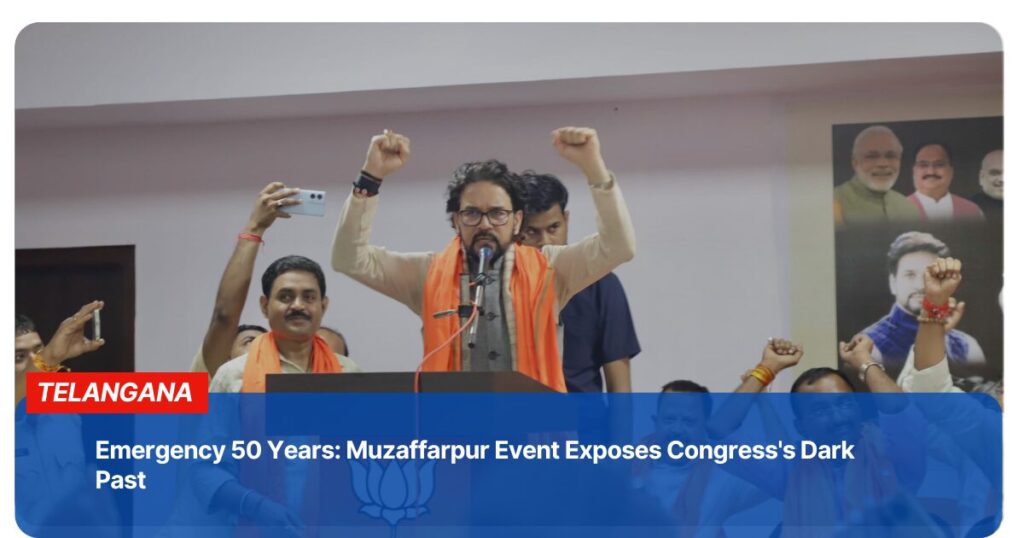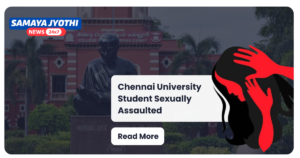- Home
- India, Latest News
- Emergency 50 Years: Breaking and Shocking Revelations in Muzaffarpur
Emergency 50 Years: Muzaffarpur Event Exposes Congress's Dark Past
Emergency 50 Years: The shadows of 1975 still linger over Indian democracy, especially in places like Muzaffarpur, where history is remembered with raw emotion. At a special event commemorating the 50th anniversary of the Emergency, the BJP office in Muzaffarpur hosted an exhibition and seminar to remind citizens of a dark period marked by Congress oppression and the chilling abuse of power. The event was not just a memorial; it was a warning against forgetting how constitutional provisions like Article 356 were twisted for political gain. The speaker addressed the crowd with conviction, recounting how President’s Rule was used 91 times to topple elected governments, revealing a pattern of authoritarian control. In 1980 alone, nine states saw their majority governments dismissed in a span of just three days, showing that democracy was treated as a disposable toy. The audience listened intently, many nodding grimly as they recalled tales their elders told them. For Muzaffarpur, these memories are personal—the town was no stranger to the crackdowns and curfews of that time. The exhibition featured newspaper clippings, photos of protests, and firsthand accounts from those jailed without trial. This gathering was not about partisan politics alone; it was about safeguarding democratic values, so that future generations would never have to endure the same trauma.
The Emergency 50 Years commemoration in Muzaffarpur underlined how fragile democracy can be when power is concentrated without accountability. The seminar’s keynote speaker described the climate of fear that prevailed from June 25, 1975, when the Emergency was declared. Citizens were silenced, journalists were imprisoned, and opposition leaders were rounded up in midnight raids. The misuse of Article 356 was not a one-off event but an institutional strategy by the Congress to impose its will on states. The speaker cited the 1980 episode when nine elected state governments were sacked in three days as a prime example of this contempt for federalism. Attendees gasped at the audacity of it, realizing how the Constitution’s safeguards were manipulated to install puppet regimes. The session also featured testimonials from political activists who survived incarceration, many of whom recalled physical torture, intimidation, and months of solitary confinement. The BJP Muzaffarpur Event aimed to keep these truths alive, resisting the sanitization of history. They distributed booklets chronicling these abuses, urging people to educate their children about the dangers of unchecked power. Congress oppression was not just historical; it was a warning for the present and future.
Emergency 50 Years has become a rallying cry for defenders of democracy, and the Muzaffarpur exhibition sought to make this more than a ritual remembrance. Instead, it became an educational campaign, highlighting the systematic ways the Congress government dismantled institutions during the Emergency. Speakers pointed out that the President’s Rule Misuse under Article 356 was part of a broader authoritarian design that went beyond the formal proclamation of Emergency. Even after 1977, when the Janata government fell, the Congress returned to its old playbook, using constitutional loopholes to remove elected rivals and centralize power. This history is not theoretical for Muzaffarpur’s citizens. During the 1975–77 period, local activists were imprisoned, and press offices raided, with copies of anti-Emergency pamphlets burned in bonfires. BJP leaders in Muzaffarpur emphasized that remembering these details is vital because attempts to whitewash the Emergency continue in mainstream discourse. The event served as a counter-narrative, a reminder that true democracy needs active defense and vigilant citizens who won’t be silenced by the threat of force.
The Emergency 50 Years event also explored how the 1975 crackdown was justified under false pretenses of national security and stability. Participants at the Muzaffarpur seminar argued that this manipulation of public fear mirrors tactics used by authoritarian regimes worldwide. During the Emergency, the government suspended fundamental rights, censored the press, and banned protests, effectively criminalizing dissent. The audience watched documentary footage showing bulldozers demolishing slums in Delhi as part of a brutal “beautification” drive, while forced sterilizations were carried out in rural clinics. In Muzaffarpur, many remembered curfews and sudden arrests that destroyed families. Speakers warned that Congress oppression wasn’t an aberration but the result of unchecked power given free rein. By highlighting these abuses at the BJP Muzaffarpur Event, organizers wanted people to see that democracy’s real strength lies in protecting the weak, not enabling the powerful. They urged citizens to hold all governments accountable, regardless of party, and to resist any erosion of constitutional values.
TRENDING
Emergency 50 Years is more than an anniversary; it is a reckoning. At the Muzaffarpur event, leaders described how the Emergency was declared after a court found Indira Gandhi guilty of electoral malpractice—a verdict that should have led to her stepping down. Instead, she chose to impose dictatorship by suspending democracy itself. The seminar’s speakers dissected this choice as a moment when personal power triumphed over institutional norms. They discussed how the Congress party used President’s Rule Misuse not only during the formal Emergency but also in its aftermath to weaken opposition-led states. The Article 356 Abuse was systematic: states with rival governments were punished, and dissent was crushed. Participants shared stories of local activists in Muzaffarpur who were jailed without charges, while newspapers faced brutal censorship. A panel of historians emphasized that forgetting these lessons risks repeating them. The BJP Muzaffarpur Event thus became a call to remember, to educate, and to strengthen democratic institutions against any future threat.
Emergency 50 Years was the theme of vivid displays at the Muzaffarpur exhibition, which included newspaper archives, photographs of rallies broken up by police, and letters smuggled from jail cells. The exhibition was designed to immerse visitors in the atmosphere of fear that pervaded the country from 1975 to 1977. One corner featured a detailed timeline of how nine state governments were dismissed in three days in 1980, illustrating Congress’s contempt for electoral mandates. Attendees debated whether India has truly learned its lessons, given that Article 356 Abuse remained common for decades. BJP speakers in Muzaffarpur said that while the Emergency ended, the mindset that enabled it persisted in some quarters of politics. The event was not only a condemnation of the past but also a challenge to remain vigilant. Parents brought children, teachers organized group visits, and students took notes to prepare essays, showing how deeply the event resonated. By telling these stories in Muzaffarpur, the organizers ensured that local history and national history were understood as one.
Emergency 50 Years resonated with young people attending the Muzaffarpur seminar, many of whom had learned about the Emergency only through textbooks. Seeing artifacts, photos, and personal testimonies made the history visceral. Organizers stressed that while India is the world’s largest democracy, it remains vulnerable if citizens are apathetic. The misuse of President’s Rule under Congress, they argued, is a cautionary tale about the fragility of federalism. During the seminar, speakers also acknowledged that vigilance must be bipartisan: any party in power can be tempted to overreach. By foregrounding Article 356 Abuse, the event aimed to educate people about constitutional safeguards and their purpose. In Muzaffarpur, where political awareness runs deep, such discussions are critical to sustaining democracy. Attendees left with free booklets summarizing key events, including the 91 instances of President’s Rule imposition and the infamous 1980 dismissals. The BJP Muzaffarpur Event served as a public classroom, teaching that democracy is not a gift but a responsibility.
Emergency 50 Years also prompted reflections on the role of civil society. Speakers at the Muzaffarpur event emphasized that journalists, lawyers, students, and ordinary citizens were the true heroes of the anti-Emergency struggle. They told stories of underground newspapers, secret meetings, and smuggled letters that kept the flame of dissent alive. In Muzaffarpur, local families recounted how they sheltered activists on the run or hid banned literature. The event highlighted that Congress oppression extended beyond politicians to target anyone who dared speak out. It also examined how courts failed to check Executive power during the Emergency, showing that institutions alone cannot save democracy without the courage of individuals. Organizers urged attendees to support press freedom, demand accountability, and educate the next generation about this history. The BJP Muzaffarpur Event was designed as both memorial and mobilization, warning that the Emergency was not merely history but an ever-present possibility if citizens are not vigilant.
Emergency 50 Years was a moment of collective memory at the Muzaffarpur exhibition, but also of collective commitment. As the event ended, speakers called for renewed dedication to constitutional values. They reminded the audience that democracy’s promise is not self-executing: it requires transparency, accountability, and participation. The misuse of President’s Rule under Article 356 was singled out as an enduring danger, showing that even constitutional mechanisms can be perverted without a vigilant public. BJP leaders in Muzaffarpur urged citizens to read history critically and recognize the signs of creeping authoritarianism, whether in censorship, police overreach, or the sidelining of dissent. The event closed with a pledge from attendees to stand up for democratic norms, to question power, and to ensure that the next 50 years do not see a repeat of the horrors of 1975. The message was clear: remembering the Emergency is not optional, it is essential to protecting the future.
Emergency 50 Years ended with a powerful appeal to the conscience of Muzaffarpur’s citizens. Organizers encouraged people to share what they learned with their families and communities, spreading awareness about Congress oppression and the importance of constitutional safeguards. As attendees left, they passed displays with the names of local heroes jailed during the Emergency, ensuring that their sacrifice would not be forgotten. The event’s final moments were somber but determined, with a vow to resist any attempt to whitewash history. The BJP Muzaffarpur Event was described by participants as essential for democracy’s health, because it reminded people that freedoms can be lost with frightening speed. By focusing on the Article 356 Abuse and President’s Rule Misuse, the seminar turned historical memory into civic education. The Emergency 50 Years campaign in Muzaffarpur stands as proof that history is not just about the past, but a guide for the future—a warning that liberty must be guarded, and that the price of forgetting is too high to pay. for potential shifts in trade relations and economic policies.
Click for more latest news. Also get top headlines and latest news from India and around the world at samaya jyothi







